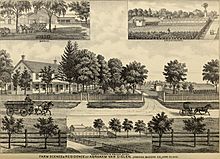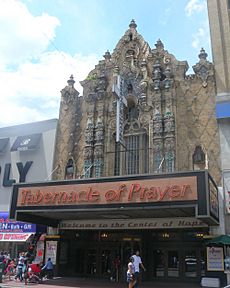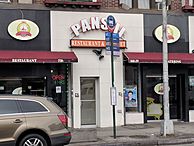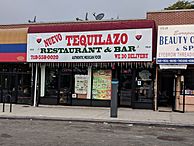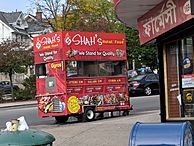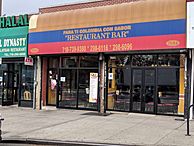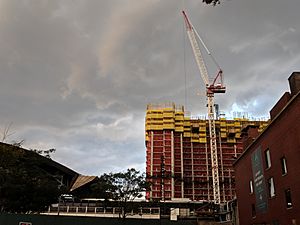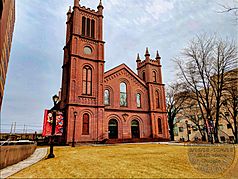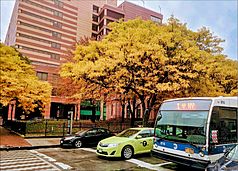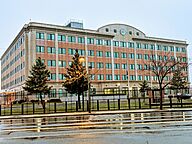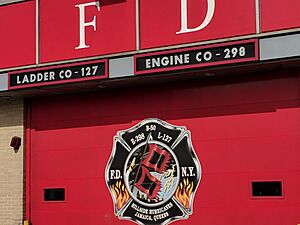Jamaica, Queens facts for kids
Quick facts for kids
Jamaica
|
|
|---|---|
|
Neighborhood
|
|
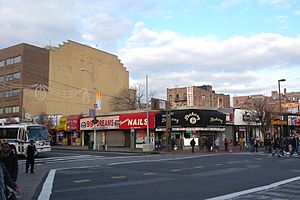
Jamaica Avenue and Sutphin Boulevard
|
|
| Country | |
| State | |
| City | New York City |
| County/Borough | Queens |
| Community District | Queens 12 |
| Languages |
List
|
| Area | |
| • Total | 2.670 sq mi (6.92 km2) |
| Population
(2010)
|
|
| • Total | 53,751 (217,000 with the subsections) |
| Ethnicity | |
| • Black | 48.2% |
| • Hispanic | 22.1% |
| • White | 19.9% |
| • Asian | 10.5% |
| • Other/Multiracial | 9.4% |
| Time zone | UTC−5 (EST) |
| • Summer (DST) | UTC−4 (EDT) |
| ZIP Codes |
11432, 11433, 11434, 11435, 11436 ect
|
| Area codes | 718, 347, 929, and 917 |
| Median household income | ,559 |
Jamaica is a neighborhood in the New York City borough of Queens. It has a large area for shops and businesses. Some parts of Jamaica are also places where people live.
Jamaica is surrounded by many other neighborhoods. To the east are Hollis, St. Albans, and Cambria Heights. To the south are South Jamaica, Rochdale Village, John F. Kennedy International Airport, and Springfield Gardens. Other nearby areas include Richmond Hill, Briarwood, and Jamaica Estates.
Jamaica was first settled by the Dutch in 1656. They called it Rustdorp, which means "rest-town." When the English took over, they renamed it Jamaica. This name comes from the Lenape language, spoken by Native Americans. It is not related to the country of Jamaica.
Jamaica was the first main town of Queens County from 1683 to 1788. It was also the first village on Long Island to be officially formed. In 1898, Queens became part of New York City. Jamaica then became the county seat again.
Today, Jamaica has many government buildings. These include the Queens Civil Court and the Queens County Family Court. The Joseph P. Addabbo Federal Building is also here. It houses offices for the Social Security Administration. The U.S. Food and Drug Administration has offices in Jamaica too. The area around Jamaica Avenue is a big shopping center. John F. Kennedy International Airport is also located in Jamaica.
Contents
History of Jamaica
What's in a Name?
The name "Jamaica" for this neighborhood comes from the Lenape language. The Lenape were Native Americans who lived here long ago. Their word Yameco meant "beaver." The Dutch, who were the first Europeans here, spelled the "y" sound with a "j." This is how "Jamaica" came to be.
The country of Jamaica in the Caribbean has a different name origin. Its name, Xaymaca, meant "land of wood and water" in the Arawak language.
Early Days and English Rule
Jamaica Avenue was once an old trail. Native American tribes used it to trade furs for wampum. In 1655, the first settlers bought land from the Native Americans. They paid with guns, a coat, and some powder and lead.
Peter Stuyvesant, a Dutch leader, officially named the area Rustdorp in 1656. This means "rest-town" in Dutch.
In 1664, the English took control. In 1683, Jamaica became the main town of Queens County. This was one of the first counties in New York.
During the American Revolutionary War, 56 local Minutemen fought in the Battle of Long Island. After the battle, British troops occupied New York City. Rufus King, who signed the Constitution of the United States, moved to Jamaica in 1805. His home, King Manor, is now a museum.
Growing Through the Centuries
By 1776, Jamaica was a busy trading place for farmers. Their horse-drawn carts traveled along Jamaica Avenue. The Jamaica Post Office opened in 1794. It was the only post office in Queens or Brooklyn for many years.
Schools like Union Hall Academy for boys and Union Hall Seminary for girls opened in 1787. These schools attracted students from all over the United States. Public schools started in 1813.
Jamaica Village became the first official village on Long Island in 1814. Its borders stretched from the Van Wyck Expressway to Farmers Boulevard. By 1834, a railroad line reached Jamaica.
In 1850, Jamaica Avenue became a "Plank Road" with a toll gate. In 1866, tracks were laid for horse-drawn trolleys. These trolleys were later powered by electricity in 1886. On January 1, 1898, Queens joined New York City. Jamaica then became the county seat.
-
George Bradford Brainerd (American, 1845–1887). Long Island Rail Road Station, Jamaica, ca. 1872–1887. Collodion silver glass wet plate negative. Brooklyn Museum
Modern Jamaica
The current Jamaica train station was finished in 1913. Subway lines arrived in 1918 and 1936. New subway lines were added in 1988. The 1920s and 1930s saw new buildings like the Valencia Theatre.
Many historic buildings in Jamaica are listed on the National Register of Historic Places. These include the First Reformed Church and King Manor.
People and Culture
Who Lives in Jamaica?
In 2010, Jamaica had a population of 53,751 people. The neighborhood covers about 1,085 acres.
Jamaica is a very diverse neighborhood. Many different groups of people live here. These include African Americans, people from the Caribbean, Hispanic people, and people from Asia.
Queens is one of the most diverse counties in the world. Jamaica shows this diversity well.
Diverse Communities
East of Jamaica, you'll find a growing community of people from East India. Many Bangladeshis have moved here because of easy transportation and many Bangladeshi stores. Bangladeshis are a fast-growing group in the area. Sri Lankans also live here, with many shops along Hillside Avenue.
From 151st Street to 164th Street, there are many stores and restaurants from the West Indies. These are mainly from Guyana and Trinidad. Many East Indian shops are located from 167th Street to 171st Street. This area is sometimes called "Little South Asia."
Economy and Development
Business Growth
For a long time, Jamaica's economy struggled. In the 1960s and 1970s, many big stores moved to the suburbs. Famous stores and movie theaters left Jamaica.
However, things have changed. The Greater Jamaica Development Corporation (GJDC) helps bring new businesses to the area. They help national chains open stores. One Jamaica Center is a large shopping complex built in 2002. It has stores like Old Navy and Walgreens. Many banks have also opened branches.
A big project was the upgrade of the Jamaica station from 2001 to 2006. This station is a major hub for the Long Island Rail Road (LIRR). It also connects to the AirTrain JFK, which goes to John F. Kennedy International Airport.
New York City is working to improve Jamaica. In 2005, a plan was made to rezone 368 blocks. This plan aims to bring new buildings and reduce traffic. The city also wants to create more green spaces and parks. This will make the area nicer for people walking around.
Real estate prices in Jamaica are rising quickly. The neighborhood's closeness to the JFK AirTrain has led to new hotels being built.
Local Businesses and Offices
The Federal Aviation Administration has offices in South Jamaica, near JFK Airport. Several businesses are also located at the airport itself. North American Airlines has its main office there.
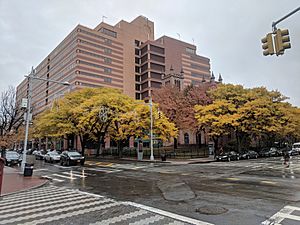
The Northeastern Program Service Center (NEPSC) is in the Joseph P. Addabbo Federal Building. This center helps many people with their Social Security numbers. The large federal building was built in 1989.
Safety and Services
Fire Department
Jamaica has four New York City Fire Department (FDNY) fire stations:
- Engine Company 275/Ladder Company 133
- Engine Company 298/Ladder Company 127/Battalion 50
- Engine Company 302/Ladder Company 155
- Engine Company 303/Ladder Company 126
Mail and ZIP Codes
Jamaica uses several ZIP Codes. These include 11432, 11433, 11434, 11435, and 11436. The United States Post Office has four branches nearby:
- Briarwood Station
- Jamaica Station
- Archer Avenue New Station
- Rochdale Village Station
Learning and Libraries
Schools in Jamaica
Jamaica has many schools run by the New York City Department of Education.
Public high schools include:
- Springfield Gardens Educational Campus
- August Martin High School
- Thomas A. Edison Vocational and Technical High School
- Hillcrest High School
- Jamaica Campus (formerly Jamaica High School)
- Queens High School for the Sciences at York College
- Queens Gateway to Health Sciences Secondary School
- The Young Women's Leadership School of Queens
- York Early College Academy
Public elementary and middle schools include:
- PS 40 Samuel Huntington
- PS 45 Clarence Witherspoon
- PS 48 William Wordsworth
- PS 50 Talfourd Lawn
- PS 80 The Thurgood Marshall Magnet School
- PS 131 Abigail Adams
- PS 160 Walter Francis Bishop
- IS 238 Susan B Anthony
- JHS 72 Catherine and Count Basie
Private schools in Jamaica include:
- Al-Iman School, an Islamic school
- Archbishop Molloy High School, a Catholic high school
- Immaculate Conception School, a Catholic school
- St. Nicholas of Tolentine, a Catholic school
- The Mary Louis Academy, a Catholic girls' high school
Colleges and Universities
Several colleges are located in or near Jamaica:
- York College, part of the City University of New York
- St. John's University, a private Catholic university
- Queens College, another college of the City University of New York
Public Libraries
The Queens Public Library has four branches in Jamaica:
- The Baisley Park branch
- The Central Library
- The Rochdale Village branch
- The South Jamaica branch
Two more branches are nearby:
- The St. Albans branch
- The Briarwood branch
Getting Around Jamaica
Public Transportation
Jamaica station is a major hub for the Long Island Rail Road (LIRR). Most LIRR lines pass through this station. The New York City Subway also serves Jamaica. The IND Queens Boulevard Line (E, F <F> trains) ends at the 179th Street station. The Archer Avenue lines (E J and Z trains) serve Sutphin Boulevard–Archer Avenue–JFK Airport and Jamaica Center–Parsons/Archer stations.
Jamaica's bus system offers wide service across eastern Queens. Buses also go to Nassau County, the Bronx, and Midtown Manhattan. Most bus lines end near the 165th Street Bus Terminal or the Jamaica Center subway station.
John F. Kennedy International Airport is in Greater Jamaica. You can get to the airport terminals using AirTrain JFK. This train connects to the LIRR and subway at Sutphin Boulevard and Archer Avenue.
Main Roads
Major streets in Jamaica include Archer Avenue, Hillside Avenue, Jamaica Avenue, and Merrick Boulevard. Other important roads are the Van Wyck Expressway (I-678) and the Grand Central Parkway.
Jamaica Avenue is the busiest street in Jamaica. It passes by the Joseph Addabbo Social Security Administration Building and courthouses. The main building of the Queens Public Library is also on this avenue. The historic King Manor Museum is at 153rd Street and Jamaica Avenue.
Hillside Avenue is another main road. It has many shops and businesses. Hillside Avenue separates Jamaica from neighborhoods like Briarwood and Jamaica Estates.
Sutphin Boulevard is Jamaica's second busiest road. It has two subway stations and stations for the LIRR and AirTrain JFK. It runs from Hillside Avenue in the north to Rockaway Boulevard in the south.
Parks and Fun
Baisley Pond Park offers over 100 acres of outdoor space. It has a 30-acre pond.
Flushing Meadows–Corona Park is near Jamaica's northwest corner. It is the fourth-largest public park in New York City. The southern part of the park is next to Willow Lake.
Other major parks near downtown Jamaica include:
- Captain Tilly Park, in Jamaica Hills
- Detective Keith L. Williams Park
- Roy Wilkins Park, in St. Albans
- St. Albans Park
Famous People from Jamaica
Many well-known people have lived in Jamaica, Queens. Here are some of them:
- 50 Cent, a famous rapper
- Khandi Alexander, an actress and dancer
- Lloyd Banks, a rapper from the group G-Unit
- Bob Beamon, an Olympian and world record holder in long jump
- Jimmy Breslin, an author and columnist
- Tina Charles, a WNBA basketball player
- Mr. Cheeks, a rapper from the group Lost Boyz
- Sri Chinmoy, a spiritual teacher
- Mario Cuomo, a former governor of New York
- Nelson DeMille, an author
- Rocco DiSpirito, a chef
- Ashrita Furman, who holds many Guinness World Records
- Scott Ian, a guitarist for the band Anthrax
- Rufus King, one of the people who signed the United States Constitution
- Jeffrey R. MacDonald, a former doctor
- Debi Mazar, an actress
- Darryl McDaniels (DMC), a rapper
- Metallica briefly lived here in 1983
- Marcus Miller, a jazz musician
- Nicki Minaj, a rapper
- Charles Mingus, a jazz musician
- Dalilah Muhammad, an Olympic track and field athlete
- Lamar Odom, an NBA star
- Richard Parsons, a business leader
- Pepa, a rapper from Salt-N-Pepa
- Joseph Simmons (Run), a rapper and pastor
- Russell Simmons, an entrepreneur
- Fredro Starr, an actor and rapper from Onyx
- Sticky Fingaz, an actor and rapper from Onyx
- Fred Trump, a real estate developer
- Donald Trump, a real estate businessman and former U.S. President
- Ben Webster, a jazz saxophonist
- Q-Tip (musician), a rapper and producer from A Tribe Called Quest
- Phife Dawg, a rapper from A Tribe Called Quest
See also
 In Spanish: Jamaica (Queens) para niños
In Spanish: Jamaica (Queens) para niños


